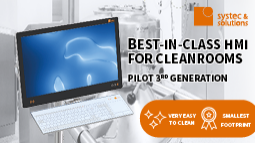Laboratory of the future: “It is not sufficient just to buy new equipment”
In an interview, Dr.-Ing. Felix Lenk explains what a good digital strategy looks like—and what changes the laboratory of the future will bring to the daily work in the laboratory. Lenk heads the SmartLab Systems research group at the Technical University of Dresden. With his team, he is organizing and designing the Action Area dedicated to the topic of Laboratory 4.0 at the upcoming analytica 2020, the world’s leading trade fair for laboratory technology, analysis and biotechnology.
Dr. Lenk, what changes does digitization bring to the laboratory?
“In the laboratory of the future, the key topics are digitalization, miniaturization, and automation. Digitalization means a complete rethinking of workflows and processes. This is coupled with novel devices that are capable of running processes without user intervention, i.e. automatically. And because laboratory workplaces are actually among the most expensive workplaces in the world, you need equipment that is more compact in order to make better use of this valuable space.”
What does this mean for laboratory planners?
“Laboratory planners need to completely rethink. Traditionally, a laboratory is a fixed installation, similar to a fitted kitchen. In most cases it should be in operation for 20 to 30 years. However, projects in the development laboratory are usually planned for up to three years only. It is difficult to predict what demands will be placed on the facility afterwards. So you need a flexible laboratory: With modules that can be combined to create ever new workflows and devices that are functionally integrated and easy to operate.”
What does this mean for the daily work in the laboratory?
“Studies have shown that scientists in development laboratories spend 70 percent of their time preparing, following up and, above all, searching, and only 30 percent of their time on real science. On the one hand, this can be changed by a stronger division of labor. On the other, new technologies—for example assistance systems—will give scientists more time to gain real insights.”
Will fewer people work in the laboratory of the future?
“Everyday life in the laboratory will change for employees, but we do not expect any job losses. Laboratories are generally well utilized. Sample numbers have been growing steadily for years. To cope with this increase, we need new technologies. However, the contents of the work will evolve considerably. Currently, a laboratory employee is carrying out processes. In the future, he or she will primarily check that devices operate within defined parameters. He/she will rectify error conditions and check the data obtained for authenticity and correctness.”
Will this make laboratories more efficient?
“Yes, in the laboratory of the future you will be able to have work done around the clock—this has a positive effect on operating costs. Currently, laboratory operation after 8 pm is absolutely unusual. In the future, night shifts will be the norm. They will be running in fully automated fashion – without human supervision.
Will the laboratory of the future work more sustainably?
“Digitization, miniaturization and automation can indeed increase sustainability. Thus, miniaturized laboratories or more experiments in the same space lead to energy savings. Another example: If cell cultures examined by new inspection methods need to be incubated for only three days instead of ten, the incubators likewise need to run for only 30 percent of the original time.”
How do I make an existing laboratory fit for the future?
“An important starting point for the digital transformation of a laboratory is a well-done workflow analysis and a plan derived from it. The starting point should be the “low-hanging fruits”: Processes that tend to be reiterated in the same way at high rates are the first candidates for digitization. Usually it is not sufficient just to buy new equipment. The transformation also comprises a digital superstructure, i.e. various questions of sample retrieval and sample nomenclature must be clarified in such a workflow analysis. In this way, a customized solution is created across manufacturer boundaries, allowing synergies to be leveraged very quickly.”
How do I experience the laboratory of the future at analytica 2020?
“The special show Digital Transformation will show for the first time how the laboratory of the future will work very specifically. To this end, 18 partners from science and industry have joined forces. Two workflows, which will be presented in a moderated manner, demonstrate device networking, collaborative robotics and user interaction. Connected to this there are six smaller workflows that visitors can try out for themselves for the first time. The laboratory of the future can thus be experienced at close quarters.”
Messe München GmbH
81823 München
Germany









